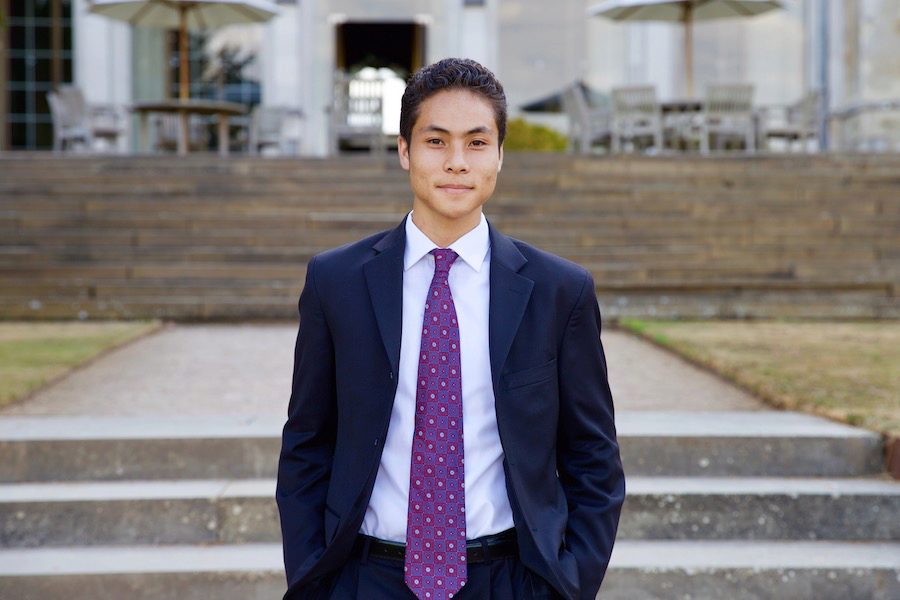
Amid winning the President’s Innovation Prize in Spring 2019 for his company and anticipating graduation, Michael Wong (W’19) planned a different kind of “summer vacation.” The destination: the Pennovation Center. There, Wong and a team — with interns hailing from Rice University to Tufts University — are working on engineering, computer science, marketing and sales, and more for Wong’s startup, InstaHub.
InstaHub makes a sensor that attaches easily to light switches and turns lights off and on, depending on whether or not someone is in the room. The snap-on technology doesn’t require a complicated, expensive rewiring of a building. The energy-saving, cost-cutting product has earned Wong and InstaHub headlines, funding, a win at Hult Prize at Penn and the Hult Prize Ivy Competition in 2018, and entry into social impact accelerators.
Wong has already tested the InstaHub prototype in Penn buildings and gleaned useful business experience and user data. Beyond refining the innovation itself, however, Wong is also focused on being a company CEO: hiring a team of interns for the summer and effectively managing them, and considering how to add customers.
Team Building With a Mission
According to Wong, more than 100 students from around the United States applied to work with InstaHub this summer. He says the company’s focus on sustainability draws talent.
“It’s a mission that attracts a lot of people. From what I’ve seen and heard, it’s the simplicity of an idea for how we can have a huge environmental impact,” Wong says.
During interviews, Wong says, he prioritized what candidates would get out of the experience. Two of the questions he considered: “What learning opportunities were they looking for? Can we add more value to them than they can add to us?”
The CEO says he learned a lot working with a group of interns in 2018. Challenges included coordinating schedules and keeping everyone busy on projects. This year, they better aligned schedules and are introducing more structure to the summer stint. He acknowledges that he doesn’t have all the answers and says he wants every team member to feel free to innovate.
“We want to really empower people to think of their own ideas,” Wong says. “We recently ordered a 3D printer — so we’re operating that for more rapid prototyping and partial mini-production — so resources to equip them to be able to really shine and innovate.”
Wong decided another worthy investment early on was having everyone on the team attend the Lightfair International trade show and conference, which Philadelphia hosted in May 2019.
“Almost everyone went. We gave them the option to spend a whole day to just walk around the trade show because some of the top leaders, customers, competitors, industry experts are all in one space where we can ask questions,” Wong says.
From Pilot Phase to More Customers
InstaHub’s testing on Penn’s campus helped Wong work through technological and user challenges to ensure the company makes a product that meets future customers’ needs. Now, he’s also thinking about customer acquisition and customer relationships.
“In facility management, people get pitched products all the time. They get free samples of final products all the time,” Wong says. Defining how InstaHub stands out from competitors, conveying the passion around energy conservation, and even figuring out a good software solution for tracking and following up on leads are all critical, he says.
“It’s a mission that attracts a lot of people. … It’s the simplicity of an idea for how we can have a huge environmental impact.” – Michael Wong
Wong’s secret for effective cold calls is making sure he’s prepared. “We spend a lot of time doing homework, of understanding,” he says, “‘What do they do? What resources do they have? What’s their current impact? What do they need? And how can we work together?’ I believe in collaboration. It’s just today very hard for anyone to collaborate if there’s not a clear picture to how we can work together because they have things to prioritize themselves as well. But it all really starts with a personal conversation, a genuine conversation.”
While InstaHub learns how to navigate business sales cycles, purchase orders, and letters of intent, Wong also ponders future possibilities for the sensor-based technology.
“There might be military applications with what we’re doing. We can hide these in rocks … . Or we can do urban planning, big data,” he says. His example: Design neighborhood amenities and businesses by analyzing when the lights are on and off. “We might be able to correlate sensor occupancy data with how much they’re paying. We can do social nudges. We see so many opportunities there on the business opportunity side with that core technology, but still with that same value proposition to make innovation more accessible.”



